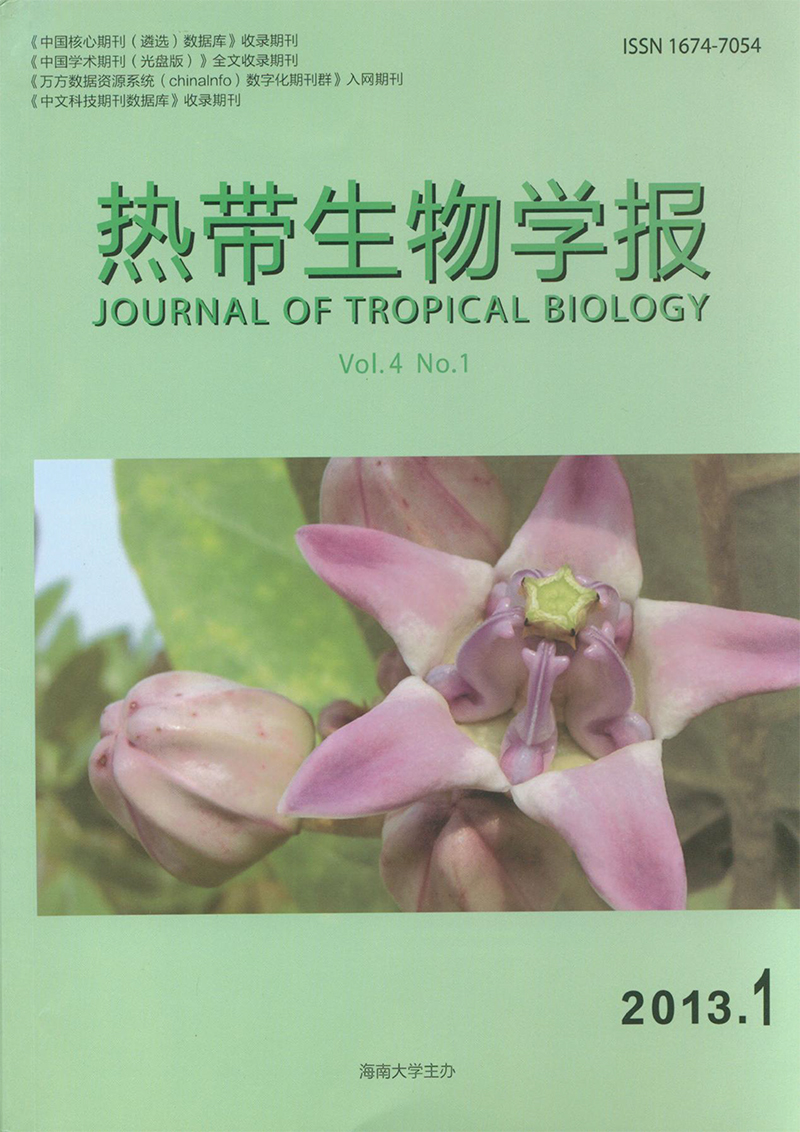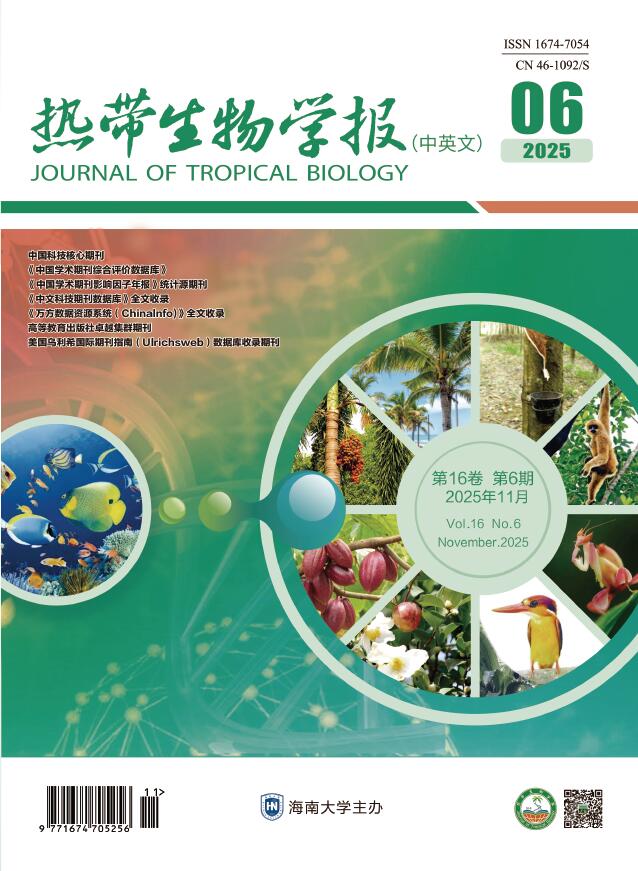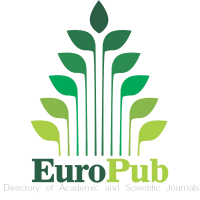2013 Vol. 4, No. 1
2013, 4(1): 1-6.
doi: 10.15886/j.cnki.rdswxb.2013.01.014
Abstract:
Sea water in the breeding ponds for commercial breeding of Epinephelus coioides based on detrital food chain was analyzed to observe the changes of and relation among its physical and chemical elements such as ammonia nitrogen,Nitrate ( NO3--N) ,nitrite ( NO2--N) ,dissolved oxygen,pH,etc. to improve its breeding method. With the breeding time going on,nitrate ( NO3--N) and nitrite nitrogen (NO2--N) content tended to increase and showed a significant linear relationship:y=4. 3854x0.287,R2 =0.8625; the dissolved oxygen content of the sea water was over 5. 7 mg·L-1 ; pH ranged from 7. 15 to 7. 92; the ammonia nitrogen content was above 5 mg·L-1 in the late stage of breeding; temperature ranged from 27 ℃ to 29 ℃ ; salinity changed from 30 to 34; average light intensity ranged from 1 075 lx to 2 329 lx; direct sunlight water area and hours during the day also showed a linear relationship,y = 0. 017 7x2-0. 187 8x + 0. 524 3,R2=0.9799. The levels of ammonia nitrogen,nitrate ( NO3--N) ,nitrite nitrogen (NO2--N) ,dissolved oxygen and pH in the pond bottom were significantly different from those in the surface and intermediate layers of sea water. All the fries lived normally during breeding.
Sea water in the breeding ponds for commercial breeding of Epinephelus coioides based on detrital food chain was analyzed to observe the changes of and relation among its physical and chemical elements such as ammonia nitrogen,Nitrate ( NO3--N) ,nitrite ( NO2--N) ,dissolved oxygen,pH,etc. to improve its breeding method. With the breeding time going on,nitrate ( NO3--N) and nitrite nitrogen (NO2--N) content tended to increase and showed a significant linear relationship:y=4. 3854x0.287,R2 =0.8625; the dissolved oxygen content of the sea water was over 5. 7 mg·L-1 ; pH ranged from 7. 15 to 7. 92; the ammonia nitrogen content was above 5 mg·L-1 in the late stage of breeding; temperature ranged from 27 ℃ to 29 ℃ ; salinity changed from 30 to 34; average light intensity ranged from 1 075 lx to 2 329 lx; direct sunlight water area and hours during the day also showed a linear relationship,y = 0. 017 7x2-0. 187 8x + 0. 524 3,R2=0.9799. The levels of ammonia nitrogen,nitrate ( NO3--N) ,nitrite nitrogen (NO2--N) ,dissolved oxygen and pH in the pond bottom were significantly different from those in the surface and intermediate layers of sea water. All the fries lived normally during breeding.
2013, 4(1): 7-10,24.
doi: 10.15886/j.cnki.rdswxb.2013.01.015
Abstract:
Strains of Staphylococci,the largest Gram positive stains,were isolated by direct plating and Gram stain from the samples of livers and gallbladders from the diseased Tilapia fry collected in Haikou. Analysis of 16S rRNA gene sequence showed that these isolates were highly homologous with Staphylococcus pasteuri and Staphylococcus warneri,but further identified to be Staphylococcus warneri by PCR amplification of the sodA gene for superoxide dismutase.
Strains of Staphylococci,the largest Gram positive stains,were isolated by direct plating and Gram stain from the samples of livers and gallbladders from the diseased Tilapia fry collected in Haikou. Analysis of 16S rRNA gene sequence showed that these isolates were highly homologous with Staphylococcus pasteuri and Staphylococcus warneri,but further identified to be Staphylococcus warneri by PCR amplification of the sodA gene for superoxide dismutase.
2013, 4(1): 11-16.
doi: 10.15886/j.cnki.rdswxb.2013.01.016
Abstract:
The oxygen consumption rate and ammonia excretion rate of Soletellina acuta were examined by using the indoor experimental ecological methods. The results showed that the oxygen consumption rate and ammonia excretion rate of S. acuta had negative power function correlation with the body mass cultured at 16-32 ℃ . At 16~32 ℃ the oxygen consumption rate of S. acuta was exponentially correlated with temperature. The oxygen consumption rate increased with the temperature,reaching the peak value at 32 ℃ ,and then decreased when the temperature was over 32 ℃ . At 16-36 ℃ the correlation between the ammonia excretion rate and temperature could be expressed with a quadratic polynomial function,and the ammonia excretion rate was maximum at 28 ℃ . The Q10 value of respiration ranged from 0. 547 to 3. 660 and the Q10 value of excretion ranged from 0. 235 to 2. 515 in S. acuta. The effects of temperature on the oxygen consumption rate and ammonia excretion rate were both significant. The ratio between the respiratory oxygen atoms and excretory ammonia nitrogen atoms (O∶N) of S. acuta ranged from 4. 312 to 21. 874. The O ∶ N ratio of S. acuta with all sizes increased as the temperature rose.
The oxygen consumption rate and ammonia excretion rate of Soletellina acuta were examined by using the indoor experimental ecological methods. The results showed that the oxygen consumption rate and ammonia excretion rate of S. acuta had negative power function correlation with the body mass cultured at 16-32 ℃ . At 16~32 ℃ the oxygen consumption rate of S. acuta was exponentially correlated with temperature. The oxygen consumption rate increased with the temperature,reaching the peak value at 32 ℃ ,and then decreased when the temperature was over 32 ℃ . At 16-36 ℃ the correlation between the ammonia excretion rate and temperature could be expressed with a quadratic polynomial function,and the ammonia excretion rate was maximum at 28 ℃ . The Q10 value of respiration ranged from 0. 547 to 3. 660 and the Q10 value of excretion ranged from 0. 235 to 2. 515 in S. acuta. The effects of temperature on the oxygen consumption rate and ammonia excretion rate were both significant. The ratio between the respiratory oxygen atoms and excretory ammonia nitrogen atoms (O∶N) of S. acuta ranged from 4. 312 to 21. 874. The O ∶ N ratio of S. acuta with all sizes increased as the temperature rose.
2013, 4(1): 17-24.
doi: 10.15886/j.cnki.rdswxb.2013.01.001
Abstract:
Full length of apolipoprotein-14 (apo-14) gene was cloned from the total RNA of Marsupenaeus japonicus. Sequence analysis showed that the full cDNA sequence was 784 bp in length including the coding region of 420 bp and encoded 139 amino acids. Homology analysis of the apolipoprotein-14 amino acid sequence indicated high sequence similarity in apo-14 amino acid sequences between M. japonicus and other fish.
Full length of apolipoprotein-14 (apo-14) gene was cloned from the total RNA of Marsupenaeus japonicus. Sequence analysis showed that the full cDNA sequence was 784 bp in length including the coding region of 420 bp and encoded 139 amino acids. Homology analysis of the apolipoprotein-14 amino acid sequence indicated high sequence similarity in apo-14 amino acid sequences between M. japonicus and other fish.
2013, 4(1): 25-30.
doi: 10.15886/j.cnki.rdswxb.2013.01.006
Abstract:
In order to develop specific SCAR markers closely linked to the gene resistant to Colletotrichum illics-kudingchae G. M. Liu et Z. Y. Zhang,germplasm materials of Ilex kudingcha with high resistance and high susceptibility to C. illics-kudingchae were collected for RAPD analysis with 92 random primers,from which a few specific RAPD markers closely linked to the resistance gene were amplified. These markers included the specific fragments: S69-300,S227-320,S227-2000 and S247-400. These specific fragments will be retrieved,amplified and sequenced. The specific RAPD fragment sequencing results can be used for development of SCAR markers linked to the resistance gene against C. illics-kudingchae.
In order to develop specific SCAR markers closely linked to the gene resistant to Colletotrichum illics-kudingchae G. M. Liu et Z. Y. Zhang,germplasm materials of Ilex kudingcha with high resistance and high susceptibility to C. illics-kudingchae were collected for RAPD analysis with 92 random primers,from which a few specific RAPD markers closely linked to the resistance gene were amplified. These markers included the specific fragments: S69-300,S227-320,S227-2000 and S247-400. These specific fragments will be retrieved,amplified and sequenced. The specific RAPD fragment sequencing results can be used for development of SCAR markers linked to the resistance gene against C. illics-kudingchae.
2013, 4(1): 31-35.
doi: 10.15886/j.cnki.rdswxb.2013.01.002
Abstract:
JAZ proteins are important negative factors for jasmonic acid ( JA) signaling pathways in Arabidopsis thaliana. NiNJA interacted with JAZ proteins to inhibit the transcription activity of JA-related transcription factors. NiNJA is a key factor that connected the JAZs and JA-related transcription factors. In order to screen NiNJA interacted proteins,NiNJA full-length cDNA sequence was PCR amplified inserted into pGBKT7 vector to construct a bait vector for yeast two-hybrid system. Furthermore,the vector was transformed into Y2H Gold strain. The result of autoactivation showed that pGBKT7-NiNJA vector had no autoactivation. Finally,the bait vector was used to screen the interacted proteins in "Mate & PlateTM "Library and several potential interacted proteins were obtained. This work laid a foundation for further identification of NiNJA interacted proteins and related signaling pathway.
JAZ proteins are important negative factors for jasmonic acid ( JA) signaling pathways in Arabidopsis thaliana. NiNJA interacted with JAZ proteins to inhibit the transcription activity of JA-related transcription factors. NiNJA is a key factor that connected the JAZs and JA-related transcription factors. In order to screen NiNJA interacted proteins,NiNJA full-length cDNA sequence was PCR amplified inserted into pGBKT7 vector to construct a bait vector for yeast two-hybrid system. Furthermore,the vector was transformed into Y2H Gold strain. The result of autoactivation showed that pGBKT7-NiNJA vector had no autoactivation. Finally,the bait vector was used to screen the interacted proteins in "Mate & PlateTM "Library and several potential interacted proteins were obtained. This work laid a foundation for further identification of NiNJA interacted proteins and related signaling pathway.
2013, 4(1): 36-44,55.
doi: 10.15886/j.cnki.rdswxb.2013.01.007
Abstract:
Cup-plate methods and plate growth rate method were used to determine antimicrobial substances of strain Czk1 of Bacillus substilis in the fermentation broth. The results indicated that the active component of this strain were extracellular metabolites and existed in the supernatant. Physicochemical analysis showed this antimicrobial component was not tolerant to high temperature and high and low acidity,and not sensitive to ultraviolet radiation,protease K,5 common metal ions and organic solvent. This component could be extracted by acid precipitation and methanol extraction. Single factor experiment showed this strain had the highest pathogen antagonistic activity when shake cultured at 28 ℃ and 180 r·min-1 for 3d on YPD medium inoculated at the rate of 7% and the initial pH7.
Cup-plate methods and plate growth rate method were used to determine antimicrobial substances of strain Czk1 of Bacillus substilis in the fermentation broth. The results indicated that the active component of this strain were extracellular metabolites and existed in the supernatant. Physicochemical analysis showed this antimicrobial component was not tolerant to high temperature and high and low acidity,and not sensitive to ultraviolet radiation,protease K,5 common metal ions and organic solvent. This component could be extracted by acid precipitation and methanol extraction. Single factor experiment showed this strain had the highest pathogen antagonistic activity when shake cultured at 28 ℃ and 180 r·min-1 for 3d on YPD medium inoculated at the rate of 7% and the initial pH7.
2013, 4(1): 45-49.
doi: 10.15886/j.cnki.rdswxb.2013.01.008
Abstract:
The toxicities of 8 fungicides against Trichothecium roseum causing mango fruit rot were tested by mycelial growth rate method. The results showed that the 8 fungicides could inhibit the pathogen of the mango fruit rot efficiently. All the tested fungicides except flusilazole could be used to control the disease caused by T. roseum. The toxicity result was analyzed according to the EC50 value,EC75 value and slope coefficient of toxicity regression equation. The toxicity of carbendazim was the highest against T. roseum with the EC50 value of 1. 30 mg·L-1 and EC75 value of 3. 09 mg·L-1 ,followed by prochloraz-manganese chloride complex,tebuconazole, myclobutanil,kresoxim-methyl. mancozeb and chlorothalonil had the lowest toxicity.
The toxicities of 8 fungicides against Trichothecium roseum causing mango fruit rot were tested by mycelial growth rate method. The results showed that the 8 fungicides could inhibit the pathogen of the mango fruit rot efficiently. All the tested fungicides except flusilazole could be used to control the disease caused by T. roseum. The toxicity result was analyzed according to the EC50 value,EC75 value and slope coefficient of toxicity regression equation. The toxicity of carbendazim was the highest against T. roseum with the EC50 value of 1. 30 mg·L-1 and EC75 value of 3. 09 mg·L-1 ,followed by prochloraz-manganese chloride complex,tebuconazole, myclobutanil,kresoxim-methyl. mancozeb and chlorothalonil had the lowest toxicity.
2013, 4(1): 50-55.
doi: 10.15886/j.cnki.rdswxb.2013.01.009
Abstract:
Using the petri dishes filter paper method,leaves of 3 plants ( Ipomoea cairica,Ipomoea triloba and Ipomoea digitata Linn) were extracted with water and used to treat four vegetables ( radish,cabbage,mustard and asparagus lettuce) to observe their seed germination and their seedling growth. The results showed that the leaf aqueous extract of I. cairica significantly inhibited seed germination and seedling growth of the four vegetables,and that the inhibition increased with concentration of the aqueous extract. At the low concentration ( 0. 1 g·mL-1 ) the aqueous extract of I. cairica inhibited 81. 3%,80. 1%,74. 2% and 64. 8% of the root growth of cabbage,asparagus lettuce,mustard and radish,respectively,while at higher concentration ( 0. 5 g·mL-1 ) it stopped the seedling growth of all the vegetables tested. The aqueous extracts of the native plant I. digitata and the weak invader I. triloba promoted seed growth of the vegetables at the low concentration,and gave a slight inhibition to the seed growth at the high concentration. The aqueous extract of I. digitata at the high concentration inhibited the root growth of the cabbage,asparagus lettuce,mustard and radish by 47. 7% ,59. 3% ,43. 6% and 22. 8% ,respectively,and that of I. triloba inhibited the four vegetables by 78. 7% ,75% ,49. 6% and 25. 1% ,respectively. The results suggest that the strong invader I. cairica has a higher allelopathic effect than the weak invader I. digitata and the native plant I. triloba.
Using the petri dishes filter paper method,leaves of 3 plants ( Ipomoea cairica,Ipomoea triloba and Ipomoea digitata Linn) were extracted with water and used to treat four vegetables ( radish,cabbage,mustard and asparagus lettuce) to observe their seed germination and their seedling growth. The results showed that the leaf aqueous extract of I. cairica significantly inhibited seed germination and seedling growth of the four vegetables,and that the inhibition increased with concentration of the aqueous extract. At the low concentration ( 0. 1 g·mL-1 ) the aqueous extract of I. cairica inhibited 81. 3%,80. 1%,74. 2% and 64. 8% of the root growth of cabbage,asparagus lettuce,mustard and radish,respectively,while at higher concentration ( 0. 5 g·mL-1 ) it stopped the seedling growth of all the vegetables tested. The aqueous extracts of the native plant I. digitata and the weak invader I. triloba promoted seed growth of the vegetables at the low concentration,and gave a slight inhibition to the seed growth at the high concentration. The aqueous extract of I. digitata at the high concentration inhibited the root growth of the cabbage,asparagus lettuce,mustard and radish by 47. 7% ,59. 3% ,43. 6% and 22. 8% ,respectively,and that of I. triloba inhibited the four vegetables by 78. 7% ,75% ,49. 6% and 25. 1% ,respectively. The results suggest that the strong invader I. cairica has a higher allelopathic effect than the weak invader I. digitata and the native plant I. triloba.
2013, 4(1): 56-60,73.
doi: 10.15886/j.cnki.rdswxb.2013.01.010
Abstract:
Cymbidium mosaic virus ( CyMV) and Odontoglossum ringspot virus ( ORSV) are the most serious viruses which affect the quality of Phalaenopsis plants. It is of a great significance to control CyMV and ORSV. Proliferation buds of Phalaenopsis inoculated with both the CyMV and ORSV viruses were used as explants and cultured on proliferation medium added with different virus inhibitors. The result showed that amino-oligosaccharin gave the highest CyMV and ORSV elimination rate,up to 83. 33% and 66. 67% ,respectively,followed by ribavirin with the respective elimination rates of 83. 33% ( CyMV) and 50% ( ORSV) . The Chinese Herbs inhibitor was the worst.
Cymbidium mosaic virus ( CyMV) and Odontoglossum ringspot virus ( ORSV) are the most serious viruses which affect the quality of Phalaenopsis plants. It is of a great significance to control CyMV and ORSV. Proliferation buds of Phalaenopsis inoculated with both the CyMV and ORSV viruses were used as explants and cultured on proliferation medium added with different virus inhibitors. The result showed that amino-oligosaccharin gave the highest CyMV and ORSV elimination rate,up to 83. 33% and 66. 67% ,respectively,followed by ribavirin with the respective elimination rates of 83. 33% ( CyMV) and 50% ( ORSV) . The Chinese Herbs inhibitor was the worst.
2013, 4(1): 61-65.
doi: 10.15886/j.cnki.rdswxb.2013.01.011
Abstract:
Cortolus versicolor Quel was cultured on solid medium added with nutrient elements of different sources such as carbon sources,nitrogen sources and inorganic salts,and the density and the growth rate of the mycelia of C. versicolor were determined to select an optimal combination of nutrient elements for growth of C. versicolor The result showed that C. versicolor Quel mycelia grew well when fructose,beef powder and MgSO4 were used as carbon source,nitrogen source and inorganic salt,respectively.
Cortolus versicolor Quel was cultured on solid medium added with nutrient elements of different sources such as carbon sources,nitrogen sources and inorganic salts,and the density and the growth rate of the mycelia of C. versicolor were determined to select an optimal combination of nutrient elements for growth of C. versicolor The result showed that C. versicolor Quel mycelia grew well when fructose,beef powder and MgSO4 were used as carbon source,nitrogen source and inorganic salt,respectively.
2013, 4(1): 66-73.
doi: 10.15886/j.cnki.rdswxb.2013.01.003
Abstract:
The present work initiated a sampling-based phytodiversity survey of the Jialize peat bog,a ten-square kilometers wetland near Kunming,China. The field investigation performed on the bog including 52 quadrates and their neighboring regions was conducted in December,2010. The bog recorded to the inventory a total of 176 plant species that belong to 137 genera and 66 families,of which 17 plant species are invasive. The 52 sampling quadrates registered 82 plant species,about 60% of the total plant species in the bog,of which five are invasive. The plant communities in the bog were classified by using two-way indicator species ( TWINSPAN) method,and their interspecific associations of 30 dominant species were analyzed by using χ2-test. Twelve communities are classified,namely Comm. Nelumbo nucifera-Lemna minor-Azolla imbircata-Lolium perenne,Lolium perenne-Vicia sepium-Artemisia argyi-Bidens pilosa,Brassica sp. -Lolium perenne-Cynodon dactylon-Bidens pilosa, Phragmites australis-Lolium perenne-Cynodon dactylon,Taraxacum sp. -Lolium perenne-Bidens pilosa-Phragmites australis,Cynodon dactylon-Bidens pilosa-Ixeris sp. ,Artemisia argyi-Cynodon dactylon-Bidens pilosa-Alternan- thera philoxeroides-Eupatorium adenophorumk, Cynodon dactylon-Phragmites australis-Alternanthera philoxeroides-Myriophyllum verticillatum,Bidens pilosa-Alternanthera philoxeroides-Calystegia hederacea,Bidens pilosa-Phragmites australis-Solanum nigrum,Malva sinensis,and Ranunculus japonicus-Rumex acetosa-Bidens pilosa. In the plant communities 435 species dyads consisting of 30 dominant plant species were selected and run with χ2 -test. Of the species dyads 42. 5% ,56. 3% and 1.2% were positively,negatively and null associated,respectively. No significant levels of either positive or negative associations are found in the plant species dyads, suggesting that the plant species under survey act as the pioneers and experience the initial stage of colonizing the region of the Jialize peat bog,suffering human activities and invasive grasses as recorded,and that this area is far from a biodiverse steady ecosystem.
The present work initiated a sampling-based phytodiversity survey of the Jialize peat bog,a ten-square kilometers wetland near Kunming,China. The field investigation performed on the bog including 52 quadrates and their neighboring regions was conducted in December,2010. The bog recorded to the inventory a total of 176 plant species that belong to 137 genera and 66 families,of which 17 plant species are invasive. The 52 sampling quadrates registered 82 plant species,about 60% of the total plant species in the bog,of which five are invasive. The plant communities in the bog were classified by using two-way indicator species ( TWINSPAN) method,and their interspecific associations of 30 dominant species were analyzed by using χ2-test. Twelve communities are classified,namely Comm. Nelumbo nucifera-Lemna minor-Azolla imbircata-Lolium perenne,Lolium perenne-Vicia sepium-Artemisia argyi-Bidens pilosa,Brassica sp. -Lolium perenne-Cynodon dactylon-Bidens pilosa, Phragmites australis-Lolium perenne-Cynodon dactylon,Taraxacum sp. -Lolium perenne-Bidens pilosa-Phragmites australis,Cynodon dactylon-Bidens pilosa-Ixeris sp. ,Artemisia argyi-Cynodon dactylon-Bidens pilosa-Alternan- thera philoxeroides-Eupatorium adenophorumk, Cynodon dactylon-Phragmites australis-Alternanthera philoxeroides-Myriophyllum verticillatum,Bidens pilosa-Alternanthera philoxeroides-Calystegia hederacea,Bidens pilosa-Phragmites australis-Solanum nigrum,Malva sinensis,and Ranunculus japonicus-Rumex acetosa-Bidens pilosa. In the plant communities 435 species dyads consisting of 30 dominant plant species were selected and run with χ2 -test. Of the species dyads 42. 5% ,56. 3% and 1.2% were positively,negatively and null associated,respectively. No significant levels of either positive or negative associations are found in the plant species dyads, suggesting that the plant species under survey act as the pioneers and experience the initial stage of colonizing the region of the Jialize peat bog,suffering human activities and invasive grasses as recorded,and that this area is far from a biodiverse steady ecosystem.
2013, 4(1): 74-80.
doi: 10.15886/j.cnki.rdswxb.2013.01.004
Abstract:
Disanthus cercidifolius var. longipes is an endemic and monotypic genus of Hamamelidaceae,and is listed as a rare and endangered species under state protection ( Category Ⅱ) in China. Data collected from 30 quadrats ( 10m ×10m) of 4 sample sites in Nanling mountains were analyzed to study the population characteristics of D. cercidifolius var. longipes,such as spatial distribution,density,age classes,etc. A static life table for the population was made and a distribution and survivorship curve was drawn in order to make clear dynamic changes of the population characteristics of D. cercidifolius var. longipes. The results showed that the individuals of the population of D. cercidifolius var. longipes was not evenly distributed but in cluster and had a high survival rate in nature or under well-protected vegetation condition. The age classes of D. cercidifolius var. longipes were distributed in a growing pattern,indicating an obvious potential of development.
Disanthus cercidifolius var. longipes is an endemic and monotypic genus of Hamamelidaceae,and is listed as a rare and endangered species under state protection ( Category Ⅱ) in China. Data collected from 30 quadrats ( 10m ×10m) of 4 sample sites in Nanling mountains were analyzed to study the population characteristics of D. cercidifolius var. longipes,such as spatial distribution,density,age classes,etc. A static life table for the population was made and a distribution and survivorship curve was drawn in order to make clear dynamic changes of the population characteristics of D. cercidifolius var. longipes. The results showed that the individuals of the population of D. cercidifolius var. longipes was not evenly distributed but in cluster and had a high survival rate in nature or under well-protected vegetation condition. The age classes of D. cercidifolius var. longipes were distributed in a growing pattern,indicating an obvious potential of development.
2013, 4(1): 81-87,93.
doi: 10.15886/j.cnki.rdswxb.2013.01.012
Abstract:
Factors ( genotypes,sucrose,IBA and AgNO3 ) affecting organogensis of 4 cassava cultivars ( NZ188, SC8,C3 and C4) were analyzed and optimized for genetic improvement. The results showed significant differences in somatic embryogenesis and organogenesis among the genotypes tested. Axillary buds of the cultivars NZ188,SC8 and C3 swelled in the dark condition and their primary somatic embryos had an inducing frequency of more than 80% ,while C4 grew better in the light condition. Somatic embryogenesis and mature somatic embryos were induced best on the medium containing 25—30 g·L-1 sucrose. The inducing frequency of adventitious shoots and the shoot regeneration rate were improved significantly on the shoot organogenesis medium at the presence of 4mg·L-1 AgNO3 and 0.3 mg·L-1 IBA.
Factors ( genotypes,sucrose,IBA and AgNO3 ) affecting organogensis of 4 cassava cultivars ( NZ188, SC8,C3 and C4) were analyzed and optimized for genetic improvement. The results showed significant differences in somatic embryogenesis and organogenesis among the genotypes tested. Axillary buds of the cultivars NZ188,SC8 and C3 swelled in the dark condition and their primary somatic embryos had an inducing frequency of more than 80% ,while C4 grew better in the light condition. Somatic embryogenesis and mature somatic embryos were induced best on the medium containing 25—30 g·L-1 sucrose. The inducing frequency of adventitious shoots and the shoot regeneration rate were improved significantly on the shoot organogenesis medium at the presence of 4mg·L-1 AgNO3 and 0.3 mg·L-1 IBA.
2013, 4(1): 88-93.
doi: 10.15886/j.cnki.rdswxb.2013.01.017
Abstract:
Observation on the maternal culture,artificial spawning and breeding of marine worm Sipunculus nudus were conducted. The marine worm was distributed in the natural sea waters at the ratio of the male to female of about 1∶1.1,and the survival rate of the maternal marine worms was the highest when cultured in fine sand ( 0.1-2.0 mm) . Maternal marine worms spawned best when forced by a combined spawning method ( drying in the air for 3 hours + running water stimulating + semen inducing) as compared with other different artificial spawning methods. When the temperature for embryonic development fell in the range of 26. 5 ℃ to 31. 5 ℃ , the initial time for larvae to hatch from the fertilized eggs was reduced as the temperature increased. Our artificial breeding tests had produced a total of 152 000 marine worms with an average body size of 2. 8 cm long.
Observation on the maternal culture,artificial spawning and breeding of marine worm Sipunculus nudus were conducted. The marine worm was distributed in the natural sea waters at the ratio of the male to female of about 1∶1.1,and the survival rate of the maternal marine worms was the highest when cultured in fine sand ( 0.1-2.0 mm) . Maternal marine worms spawned best when forced by a combined spawning method ( drying in the air for 3 hours + running water stimulating + semen inducing) as compared with other different artificial spawning methods. When the temperature for embryonic development fell in the range of 26. 5 ℃ to 31. 5 ℃ , the initial time for larvae to hatch from the fertilized eggs was reduced as the temperature increased. Our artificial breeding tests had produced a total of 152 000 marine worms with an average body size of 2. 8 cm long.
2013, 4(1): 94-98.
doi: 10.15886/j.cnki.rdswxb.2013.01.013
Abstract:
The origin of chicken,the diversity of mtDNA,microsatellite,Z chromosome,and high-throughput SNP genotype of chicken were reviewed in order to provide reference for further research in the origin of Chinese native chicken,guiding their breeding.
The origin of chicken,the diversity of mtDNA,microsatellite,Z chromosome,and high-throughput SNP genotype of chicken were reviewed in order to provide reference for further research in the origin of Chinese native chicken,guiding their breeding.
2013, 4(1): 99-104.
doi: 10.15886/j.cnki.rdswxb.2013.01.005
Abstract:
The principle and features of laser scanning confocal microscope ( LSCM) are described,based on which the application of laser scanning confocal microscope ( LSCM) in bioscience studies and some application skills is summarized.
The principle and features of laser scanning confocal microscope ( LSCM) are described,based on which the application of laser scanning confocal microscope ( LSCM) in bioscience studies and some application skills is summarized.



 Abstract
Abstract PDF 752KB
PDF 752KB



 Email alert
Email alert RSS
RSS